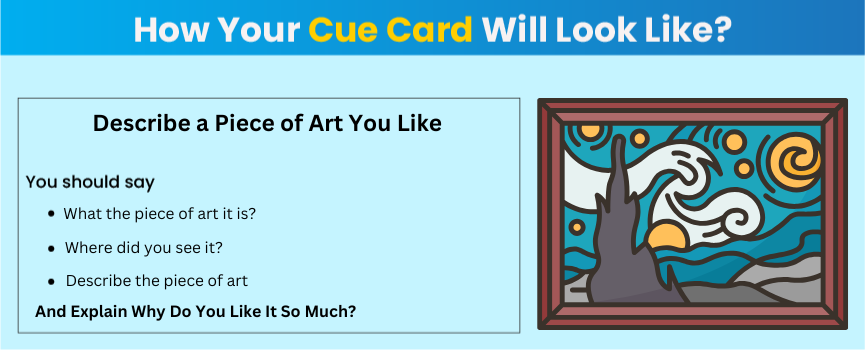Have you ever encountered an image or piece of art so powerful that it completely shifted your perspective? Or just think you get a topic on this to Describe A Piece of Art You Like- IELTS cue card? This type of question is asked in the IELTS speaking section, part 2 task, where you have to read the prompt and give an answer in your language by covering the major points. Many students struggle with answering this, but regular practice can be the paradigm shift for you. Therefore, in this blog, you are going to explore samples, follow-up questions, lexical resources, and more to answer this type of cue card topic.

Table of Contents
In the IELTS speaking section, there are three tasks, and one of the tasks is a cue card. This assesses the test taker’s coherence, fluency, vocabulary, grammar, and ability to organize thoughts. An IELTS cue card is a task where you have to talk about a specific topic for 1 to 2 minutes. You get a prompt in which you get a topic and one minute to read and prepare the structure. Afterwards, you have to give answers covering all the points mentioned in the prompt. In this IELTS speaking part 2 task, you can get any topic based on objects, places, people, experiences, and the list goes on. As topics can come out of the blue, just like Describe a Piece of Art You Like- IELTS cue card, you must be prepared enough to answer this. Hence, the correct answer can lead you to achieve a high band score. So, let’s check out the next section to understand the right approach to answer this IELTS cue card.
To answer the IELTS cue cards, you must follow certain steps, which are mentioned below. Have a look.
1. In one minute, understand the topic and instruction, and brainstorm the topics to jot down bullet point notes. Focus on key ideas, supporting details, and examples. Further, arrange your points so that they can help you speak and maintain a logical flow during your response.
2. The second step is speaking, for which you get 1-2 minutes.
3. In conclusion, the IELTS cue card answer with a brief conclusion by sharing your experience or opinion.
Use these steps to answer Describe a Piece of Art You Like- IELTS cue card. In addition, the questions of this cue card can be like this
Have a look at this image to get a better overview of how this question will look in the cue card.
This is what the question of this cue card topic will look like. To give you an idea of how to answer this topic, we have shared three sample answers in the next section. Let’s explore them one by one.
Here is the first sample of Describe a Piece of Art You Like. Go through the sample to know the approach to answering this topic.
Art, paintings, and portraits have always spellbound me, which led me into deep thought about why and how this painting was made by the artist. Today, I'm going to talk about one of the arts that we are all familiar with.
The piece of art is Mona Lisa, painted by Leonardo da Vinci, who was an Italian polymath of the High Renaissance. It is a representative and naturalistic style of painting. The art implies many sorts of paintings in one canvas, such as landscape, photographic, narrative, abstract, symbolic, or Artivism styles.
Me and my family were on a trip to Paris, where we visited the Louvre Museum, where I got the chance to see the famous painting of Mona Lisa. We hired our guide, who explained everything about the painting, as he has many information about the paintings as his late father was in this profession.
The Mona Lisa painting is globally recognised, and it resembles a Renaissance portrait of the Virgin Mary, who was a feminine ideal. This art shows the half-length portrait of a woman’s upright folded arms in a “pozzetto” armchair, showcasing her guarded posture. In addition, the lack of outline in the painting makes the woman appear typically alive. The artwork is popular for its sfumato technique, used to create this painting.
I liked this painting because Leonardo da Vinci has impeccably drawn the perfect facial expression. As a painter, I understand the work and effort required to put every piece of art into a painting to make it a flawless painting.
The painting of Mona Lisa is a resplendent painting, and anyone interested in painting will give full attention to this painting to look at every detail the artist made to make it look real. Thus, this is the reason why I liked this piece of art so much.
This is the second sample of Describe a Piece of Art You Like that can help you to know the method of maintaining fluency, accuracy and time. So have a look at this.
I would like to talk about the painting that I have in my house. Although my house is full of paintings, as my sister made them, and she is also a famous artist. Her sketches and paintings are so astonishing that they make every visitor stop and stare for a while.
The piece of art is of two young ladies who are sitting and chatting. This painting always reminds me of my sister, and to surprise, it is rendered by my sister herself, as she is a great artist.
The portrait in our home was painted last year. The suggestion to create this piece of art was given by my mom. As she wants to have it as our memory because we both live in different cities due to studies and work purposes.
This painting is a camera-clicked photo that is converted into a realistic painting by using realism and photorealism styles to depict the picture-perfect replication that looks like a photograph. Although my sister only makes scenery, natural scenarios, characters, and more, this painting gets major attraction. It was difficult for my sister to copy and paste the exact expressions on the canvas. But she did it so flawlessly.
This piece of art was gifted to me on my birthday, and it is really close to my heart. Also, a quote is written above the painting, “having a sister is just like a built-in best friend for life,” which perfectly fits for us. Also, whoever steps into our home, they see this master piece and always appreciate her efforts.
Overall, this is the first painting that comes to mind whenever someone asks me about any artwork or painting I like that is a master piece of art made by my sister.
This is the third and last sample of Describe a Piece of Art You Like that can assist you to score an 8+ band score in the exam.
It is said that faults cannot be amended after completion, but what if they are spoiled and make a staggering piece of art? Today, I am going to talk about the art that requires a great amount of focus and patience.
The piece of art is Resin art made up by using Epoxy resin, a liquid chemical amalgamated with various additives and pigments to make a blend of distinct textures and patterns that craft a resin art. Moreover, it is crucial to work with resin as it eventually hardens when it comes in contact with solid plastic, as a chemical interaction takes place between its components.
I saw the resin art for the first time in my school when I was passing by the lab, and from the window I saw my fine arts teacher making a resin art. It was my math period going on, and I was unable to see this, but after school, I visited the art lab and saw the most exquisite table that my teacher curated in my school art lab. She quantified that it took her three weeks to make a big and eye-catching resin table.
The resin table is a contemporary luxury piece of art. The table used for making this is of high-quality synthetic material that is robust. It has delicate glass and provokes a clear water-like appearance. It shows the effect of a beach, water, sand, with a touch of orange and yellow colours of sunset that are coming together and making a tempest like effect that looks striking to the eyes.
In my life, I have never seen an awestruck piece of furniture; words are not enough to express how good it looks, which goes far beyond the expectations of any person. Moreover, the quality of craftsmanship was noteworthy.
That one master piece of art is resin that encouraged me to become a resin artist, and this dream helped me to make many resin artworks, which are appreciated by many people currently. All thanks to my fine art teacher for introducing me to this art.
It is important to use vocabulary for IELTS cue card because it carries 25% of the speaking scores and allows test takers to express themselves with great fluency and exactness. This showcases your language skills and helps to communicate ideas precisely. In the above sample, we have used a range of vocabulary to express the IELTS speaking part 2 task, and here is a separate list of that. Add this to your word book to use in solving other cue cards.
| Vocabulary word | Meaning |
|---|---|
| Spellbound | Attractive or fascinating |
| Sort | Different types |
| Resembles | To look like something |
| Impeccably | To be perfect or flawless |
| Resplendent | Brightly coloured in an impressive and attractive way. |
| Astonishing | Very surprising |
| Rendered | To make something |
| Realism | A style of painting used to make realistic art. |
| Amended | To change something in order to make it better |
| Staggering | Amazing |
| Amalgamated | Blended or mixing |
| Exquisite | Extremely pleasing and beautiful |
| Curated | Selected or organised |
| Contemporary | Modern or belong to the present time. |
| Tempest | Connected to each other to form a structure. |
Once you complete part 2, the examiner asks follow-up questions based on your answer. This is the third part of the IELTS speaking section, and it is designed to assess your ability to communicate fluently and answer complex topics. So, for the topic Describe a Piece of Art You Like- IELTS cue card, the examiner can ask these types of follow-up questions. Have a look at them to get an idea of how to answer them.
1. Should children learn more about art?
Answer: According to my perspective, art is a creative way to foster and work on the young mind. If any children indulge in making arts, they can develop skills like brainstorming, teamwork, expressing their emotions, problem-solving, and creativity. Also, art helps to build self-esteem in children, communicate their ideas and feelings, and enhance their ability to communicate their ideas and feelings.
2. Why do some people think it is difficult to understand art?
Answer: Sometimes art can be too complex to comprehend, and for many people, it goes beyond their understanding. Also, art can be subjective, and interpretations vary greatly from person to person. One of the famous artists depicts that even a single stroke of paint can tell a story if it is expressed well. Additionally, I think that understanding the art is itself an art that many don’t possess, as it may require belonging from a special perspective.
3. How does art influence society?
Answer: Art influences society in various ways, such as preserving culture, shaping social identity, fostering creativity and innovation, and offering a means for emotional communication and expression. Also, it can inspire change, foster empathy, and provoke thought. For instance, classical art can express historical narratives that influence how we view our past.
4. Do you think art can be a form of communication?
Answer: Yes, art can transcend language barriers and may convey ideas and emotions that words cannot express sometimes. For example, a commanding painting can induce feelings of joy, anger, or sadness. This allows the audience to connect and understand the artist's message on a deeper level, nurturing dialogue and thoughts.
5. Have you ever created any art yourself?
Answer: Yes, I have created many arts since I was an infant. I liked to sketch and draw by taking inspiration. Gradually, I also enrolled in the art classes, where professional artists help students make art and let us know how to express emotion through sketching. While I may not be as skilled an artist as da Vinci, art allows me to express my thoughts and feelings. It feels like a therapeutic process that assists me in exploring my creative side and connecting with my emotions.
Have you developed any strategies or tips to solve the IELTS speaking part 2 task? If not yet, then use the powerful tips. This will help you to answer the Describe a Piece of Art You Like- IELTS cue card-like topics.
1. Focus on using a 1-minute time to jot down the key points and keywords to structure your answer.
2. Begin with a strong introduction that attracts the examiner’s attention.
3. Use a wide range of vocabulary, a mix of complex and simple sentences, and transition words (additionally, however, moreover, similarly, etc.) to connect ideas.
4. Use personal stories, real-life examples, and specific details to answer more relatable and interesting.
5. Speak like you are having a conversation with the examiner rather than sounding unnatural.
6. Use mock tests offered by offline or online IELTS classes as they provide the latest mock test, practice paper, and sample paper that consist of new topics.
7. Use linking words, phrases, and idioms to ensure a smooth and logical flow.
We have reached the end of this guide, after exploring all the major points to answer the IELTS cue card effectively to get an 8+ band score. The IELTS cue card may break or make your score if you answer it correctly. However, while answering the IELTS cue card, many students make mistakes such as missing any point, getting nervous, not maintaining time management, and more. Thus, if you want to overcome these mistakes, you can reach Gradding.com. Professional IELTS experts will guide you to a better pathway to answer the cue card. Also, you can use their tools like the IELTS band score calculator, essay checker, and many more in preparing for the IELTS exam.

We are available in :
BangaloreAhmedabadJaipurHyderabadKeralaPuneChandigarhMumbaiGurgaonChennaiKolkataTrivandrumNoidaKochiCalicutKottayamKollamThrissurIndoreUdaipurdisclaimer:logos and other registered trademarks of universities used on this platform are held by their respective owners. Gradding does not claim ownership or association on them, and their use is purely for informational and illustrative purposes.






